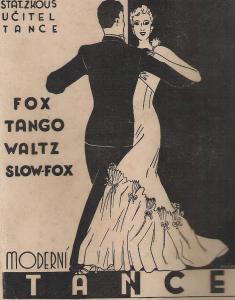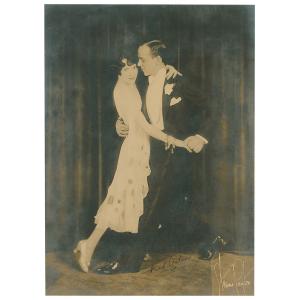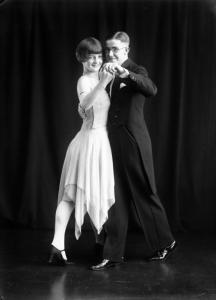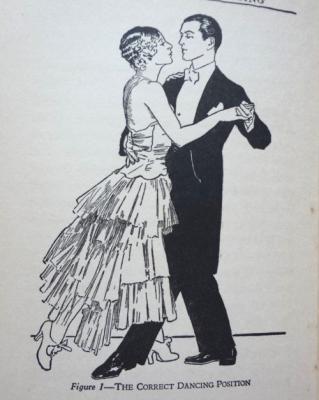- Historical Dance
- Jazz Age Social Dancing ("The Modern Dances")
- 0. The Essentials of Jazz Age Ballroom Dancing
- 1. Foxtrot Part 1: The Jazz Age Foxtrot
- 2. Youth Dancing in the Jazz Age
- 3. The Jazz Age Waltz
- 4. The Jazz Age Tango
- 5. 1930s Rumba
- 6. 1930s Samba
- 7. 1930s Conga
- 8. Bal Musette: Parisian Dance of the Jazz Age
- 9. Dancing in Weimar Berlin
- Dancing Made Easy - 1922
- Film Library - Jazz Age Dance
- Historical Dance Films posted to Pinterest
- Jazz Age Dance - Apologia
- Jazz Age Dance Image Collection
- Jazz Age Lead and Follow
- Places to Dance in Southern California in the Jazz Age
- Sampler of Jazz Age Dance Holds
- The Pathé Historical Dance Collection: 1920s-40s
- Ragtime Dance - the One Step
- Regency Dance
- Victorian Dance
- Jazz Age Social Dancing ("The Modern Dances")
Jazz Age Social Dancing ("The Modern Dances")
 In the Jazz Age, nearly everyone danced, so they did dances almost anyone could do.
In the Jazz Age, nearly everyone danced, so they did dances almost anyone could do.
Generally, when people think about the dances of the Jazz Age (the 1920s & 30s), they bring to mind exuberant youth dances like the Charleston or Lindy Hop, or the theatrical dances of Fred and Ginger.
What Fred & Ginger did was theater and spectacle, and was never intended to be an accurate representation of how ordinary folks danced. Countless examples of normal, workaday social dancing can be seen in movies of the period but not being done by exhibition dancers like Fred and Ginger. If you want to see how it was really done, look at the folks in the background or characters who are dancing to move the story along rather than to show off their skills.
The most common misconception however is our tendency to assume that everyone, regardless of age, social status, ethnicity or geography was dancing the latest fad youth dance of the moment: be it the Charleston, the Black Bottom, Collegiate Shag or Lindy Hop. Given the complexity and physical demands of these dances, this defies simple logic and any review of the films of the time will show that these youth dances had a definite place, but they were danced by a minority of the total dancing population - and even those who danced them did not limit themselves to those dances (unlike many current dancers).
The most popular dance of the period was the Foxtrot. The Waltz and the Tango were also widely danced, as were (in the '30s) Latin dances like the Rumba, Conga and Samba. The under-thirty crowd danced these mainstream ballroom styles, but also enjoyed those exuberant athletic dances that would have caused most of their elders to bust a gut.
 All of these dances are still part of today's ballroom repertoire. However, dances evolve over time and the dances we now call by those names are not what they were in the 20s and 30s.
All of these dances are still part of today's ballroom repertoire. However, dances evolve over time and the dances we now call by those names are not what they were in the 20s and 30s.
Fortunately, while they differ from what is taught today, they differ primarily in that the Jazz Age dances (referred to at the time as "The Modern Dances") were FAR EASIER than their current descendents. An experienced dancer will pick them up right away, and most beginners should be able to get out on the floor with a minimum of instruction - perhaps even after just looking at these few web pages.
"And the modern dances are the most easily achieved - some absurdly simple. It was not so in Mother's time-for the steps she watched were many and varied. With her usual quiet fortitude she prevailed over a most difficult and intricate order of things - and with an application that might, in these days, be considered a mental strain."(Dancing Made Easy 1922)
My Philosophy
A quick note on my philosophy of research and teaching: I will present my sources (largely old films, with some books and images thrown in) and make a few observations. Mostly though, I let the sources speak for themselves. You are welcome to look at the same sources and draw differing conclusions. The heart of this enterprise is making useful sources easily available, and letting peoples' interpretations of them fall where they may.
Further (and this is key) I will try to avoid defining any given thing as "correct". I will try to present the vast diversity and even anarchy of the Jazz Age dancefloor, and try to present what was typical rather than deferring to the ideas of what was proper from one of the many self-appointed dance authorities of the time (sorry Arthur Murray). Dance manuals and instructional films are valuable sources for the dance of the period, but so are films that show styles and variations not mentioned, or even scorned, in "authoritative" sources. I believe all the sources are fair game for you in selecting the elements you want to include in your own personal interpretation of Jazz Age dancing.
Variations on a Theme
One of the most striking things about the ballroom dances of the era is how like each other they are. The steps are all walks and glides (more walking than anything else), and a variation from one may be easily dropped into another. Even the Waltz seems more like a Foxtrot than what you might have seen in the 19th Century.(For a brief discussion of how every dance became just walking, see The Ragtime One Step)
 The only thing separating one from another is the tempo and, to some extent, the attitude.
The only thing separating one from another is the tempo and, to some extent, the attitude.
"After a true analysis you will find these dances are composed of but walking and gliding steps, and as you become familiar with them, and your self-reliance grows, you may take liberties with them; in other words, you may use your own variations whenever you like and as often as you like-there is no set rule; you may change them at times to please yourself; for after all you have been but walking and gliding. So while dancing around you may eventually give way to the exact number of walking steps, and perhaps, having a tete-a-tete with your partner, you may overstep that certain number; but in doing this do not worry-you are not breaking any laws either national, local, or social."
Dancing Made Easy, Coll, 1922
And always remember, my friends, that this is the Jazz Age, and Jazz isn't about rules, it's about freedom.
A Note on Variations
The films and literature of time are replete with announcements of "A new dance". These "new dances" were invariably just optional step combinations, usually for a fast or slow Fox Trot. On any given dance floor, one couple could be doing the step combination for "The Sugar Step", while another was doing "The Baltimore" and another "The Crawl Charleston". They were all doing the all-encompassing dance that was Fox Trot and could, if they felt the urge, mix and match those and any number of other combinations in any way they saw fit. All of these "new dances" should be viewed as part of a wider dance context, and not taken in isolation.
The Dance Hold
One of the distinguishing features of Jazz Age dancing was the hold. The "ballroom position" of the Jazz Age was extremely close: body-to-body. It was a gentle embrace rather than a "frame". There was no daylight between partners. People of the era, if they were of similar heights, really could, and frequently did, dance cheek to cheek.
This results in a dance that is very different from eras where the partners have some distance between them. This embrace is not a minor stylistic detail, it is an essential part of the dance and everything flows from this foundation of two people in close physical contact.
Because of this close embrace, the lead differs from the modern "frame" where partners are distinctly separated. The ballroom frame of today relies on dynamic tension to allow the lead to quickly impart cues to his partner with his arms, hands and body while the lady's arms offer constant resistance and tension so she knows instantly when something is happening. A modern frame allows the lead to easily steer his partner through any number of broad and kinetic moves and is perfect for a modern style that is focused on the outward visual impact of the dance. It was not so in the Jazz Age.
 The Jazz Age position imparts a very different spirit to the dance. It is gentle, relaxed and without dynamic tension. The lady does not exert pressure or resistance, but rather settles into the lead. The leader leads mostly with his body, his core, and tries to set up an easy flow without violent or sudden changes. The follower gets her cues from the fact that her body is in direct contact with his. The follow is relaxed and, given that the underlying step can change at any moment, she should try not to anticipate, but try to go with the flow. With this easy, relaxed hold, while the dance can sometimes be quite lively and fast-moving, it generally does not use broad moves, swooping or flinging. They move as a single unit. It is far more self-contained and inwardly focused than you would see on "Dancing With The Stars".
The Jazz Age position imparts a very different spirit to the dance. It is gentle, relaxed and without dynamic tension. The lady does not exert pressure or resistance, but rather settles into the lead. The leader leads mostly with his body, his core, and tries to set up an easy flow without violent or sudden changes. The follower gets her cues from the fact that her body is in direct contact with his. The follow is relaxed and, given that the underlying step can change at any moment, she should try not to anticipate, but try to go with the flow. With this easy, relaxed hold, while the dance can sometimes be quite lively and fast-moving, it generally does not use broad moves, swooping or flinging. They move as a single unit. It is far more self-contained and inwardly focused than you would see on "Dancing With The Stars".
To assume the position, the lady nestles her left side against the gentleman's right. The gentleman places his right arm behind her, holding very lightly. His right hand could rest on the small of the lady's back or higher, between the shoulder blades, or encircle her waist. Since his right hand is not the primary element of the lead, he may lightly place the side of his hand against her back rather than the palm (nice to do if your palm is sweaty). Mostly though, it's about what feels comfortable given the relative heights of the dancers and their own preferences. In looking at dancers of the era, they are pretty consistently in a very close hold, but nearly every other detail is subject to individual interpretation.
The feet should be offset, so that the dancers' left feet, if they step forward, will pass to the outside. Both the man and woman's right feet should be positioned to pass between the partner's legs.
They join their free hands in one of many possible holds, some rather bizarre and affected to the modern eye. She rests her left hand on the man's forearm or shoulder or where ever it seems to fit - or if she is particularly fond of him, encircling the back of his neck. The lady would put her head where ever it felt right to put it - a bit apart, or with her face turned to one side, or cheek to cheek or even resting on a taller man's chest.
If the lady was wearing a long 1930s style evening gown, she could use her left hand to lift it out of the way.
If the man is significantly shorter than the woman it can be a bit awkward. This awkward geometry was frequently played for comic effect in the films of the era. If you should find yourself in this position, I can only suggest that you use common sense and discretion to minimize the comic possibilities - or if you and your partner are up for it, have as much fun with it as Shorty George & Big Bea, or the film makers of the Jazz Age.
It is striking how the sense of "personal space" differed between now and then. The people of the Jazz Age seemed much more comfortable with being in close physical contact than we do today - even when dancing with members of the same sex. Women dancing with women (as they very often did) and even men with men (such as on shipboard) assumed the same close hold without, it would appear, worrying about it being "gay". It was a different time.
Once joined in this embrace, dancers seldom left it. Watching film from the period, among adult dancers, one seldom sees under arm turns, swing-like "throw-outs" or much else that caused the partners to separate. The style appears to be the polar opposite of something like Swing. In Swing, the dancers were open, flashy and showing off for their peers. In the "Modern Dances", the performance aspect was explicitly absent. The partners remained together, focused on one another rather than an audience and didn't do anything that might be disruptive on a crowded floor; while they moved steadily around, more or less in line of direction (counter clockwise)
- Next: The Foxtrot
- Additional Material: A sampler of possible dance holds
- Additional Material: Some musings on social dance and how our culture has changed
- Additional Material: My Jazz Age Journey: A Few Thoughts on Historical Dance
- Lessons and Instruction
| > |
Publishing information Author: Walter Nelson Publisher: Walter Nelson Date of First Publication: March 1st 2012 Date of Last Update: July 26 2017 |
